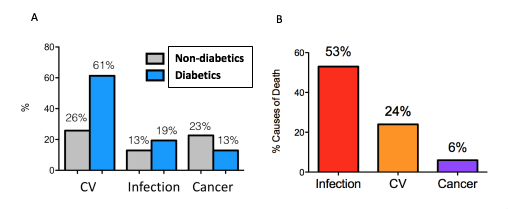Understanding the causes of mortality post-transplantation – there is more than meets the eye
Author:
Riella LV
Abstract
Death with a functioning graft is the leading cause of late graft loss. The underlying cause of death post-transplantation varies in different populations. Therefore, it is an essential task of any individual transplant program to understand those causes in order to improve long-term outcomes. In the US, the three leading causes of death after transplantation are cardiovascular disease, malignancy, and infections. Cosio et al. reported that while cardiovascular mortality is higher in diabetics post-transplantation, cancer is the most common cause of death in non-diabetics (Figure 1A).1 On the contrary, infections seem to be a dominant cause of mortality in developing countries.2-5 In addition to traditional risk factors, such as prior history of heart disease, diabetes, and recipients’ age, pre-transplantation length on dialysis, rejection events, and donor organ quality may all play additional roles in shaping the post-transplant course. Importantly, socioeconomic factors and environmental exposures further complicate and determine the ultimate outcome.
J Bras Nefrol. 2018 Apr-Jun;40(2):102-104.
Figure 1.Causes of death post-transplantation. A, Causes of death of diabetic and non-diabetic kidney recipients in a single center in the USA with mean follow-up of 4 years (adapted from Cosio et al. AJT 2008:593). B, Causes of death of kidney recipients in a single center in Brazil with mean follow-up of 5 years (Ruppel et al. BJN 2018).

